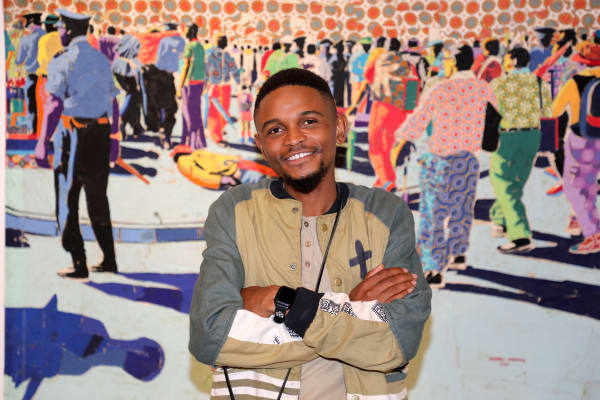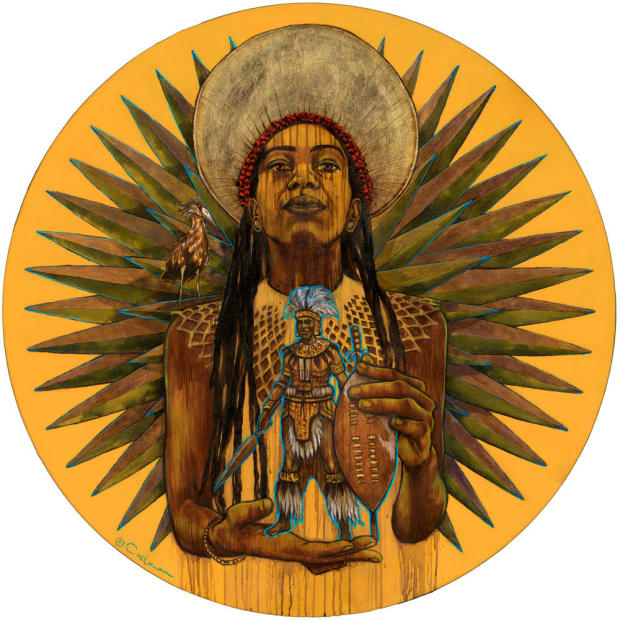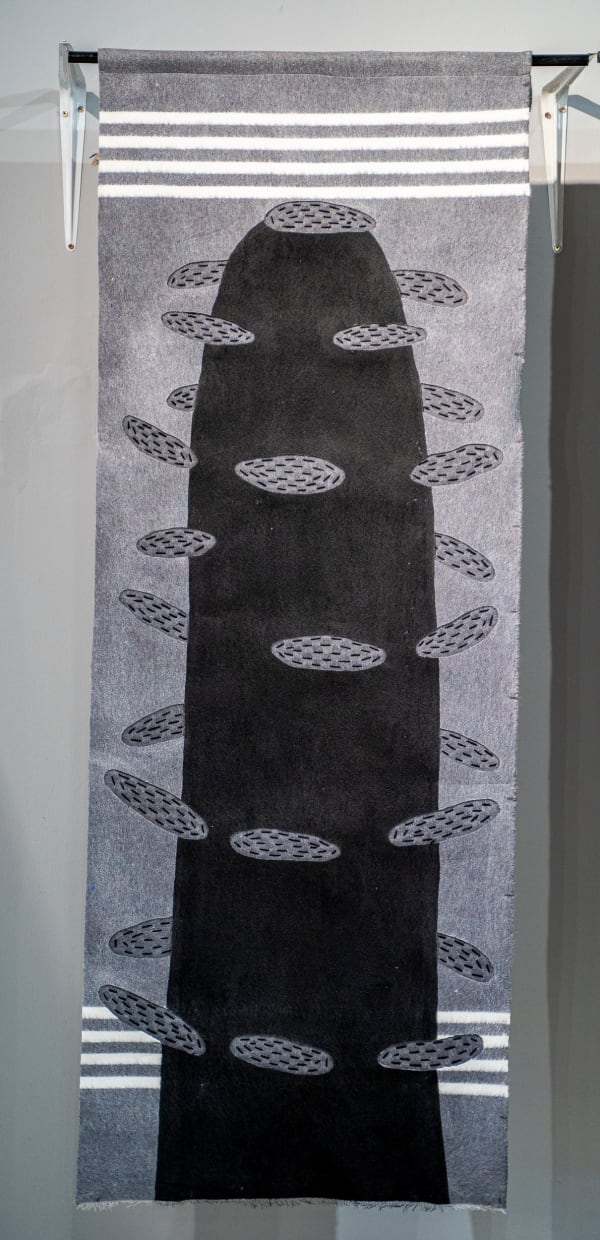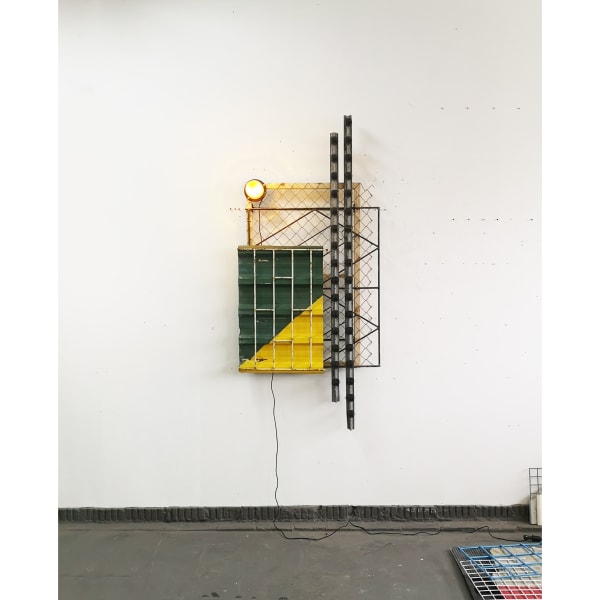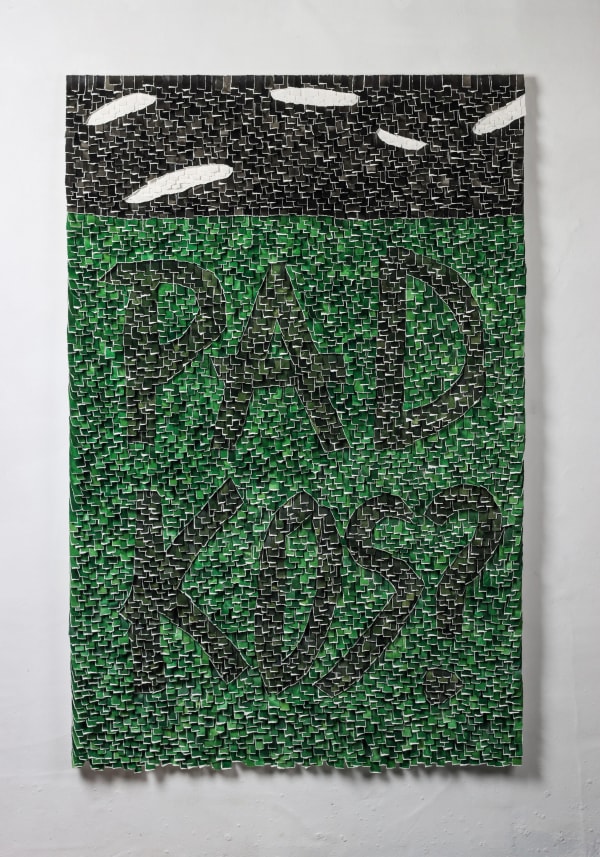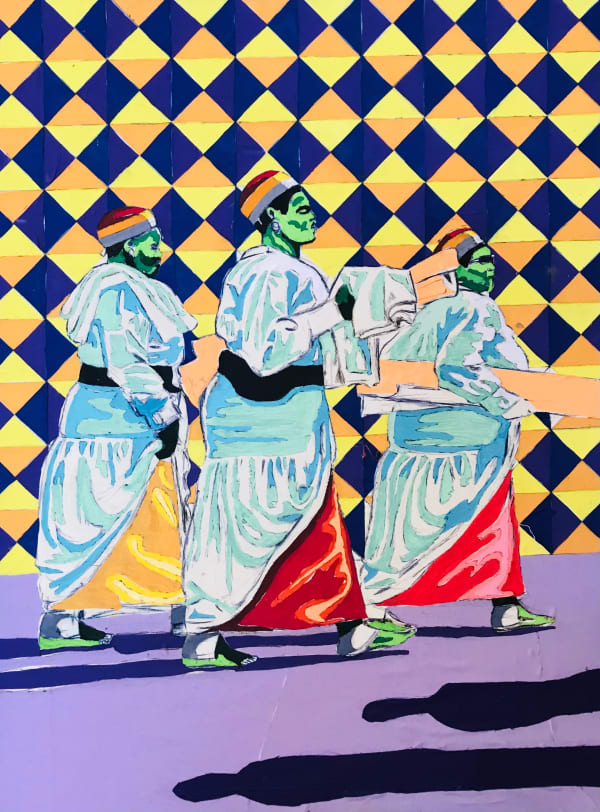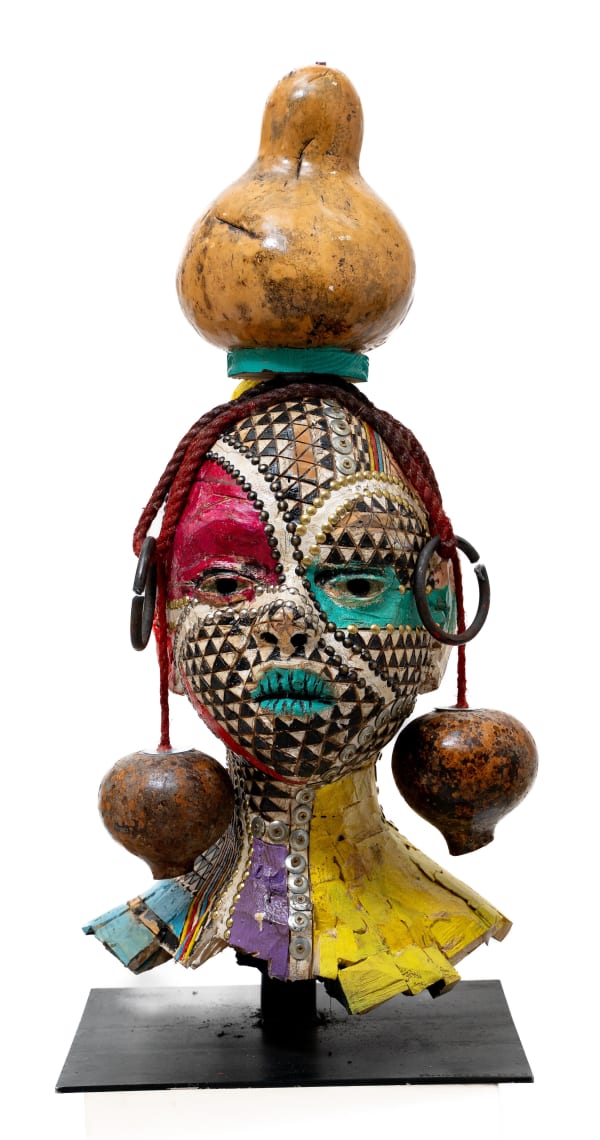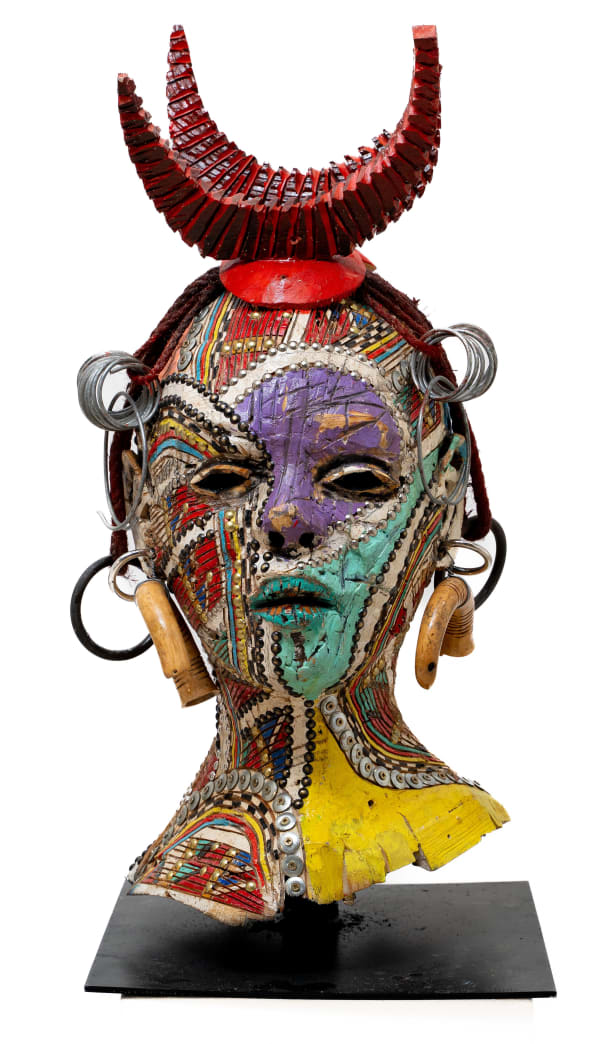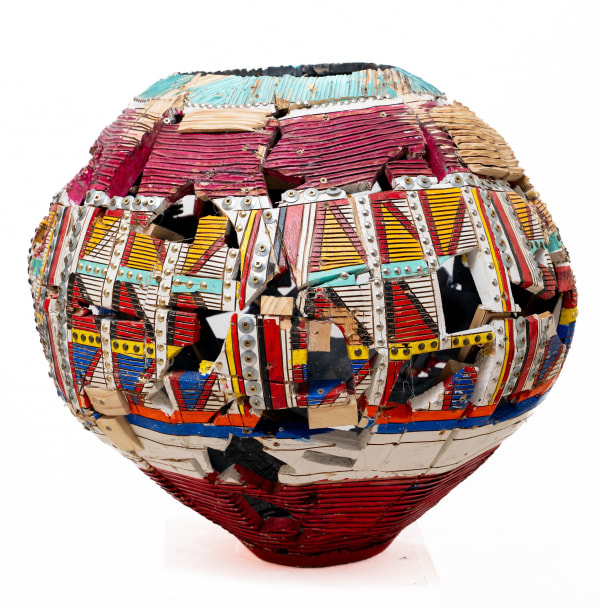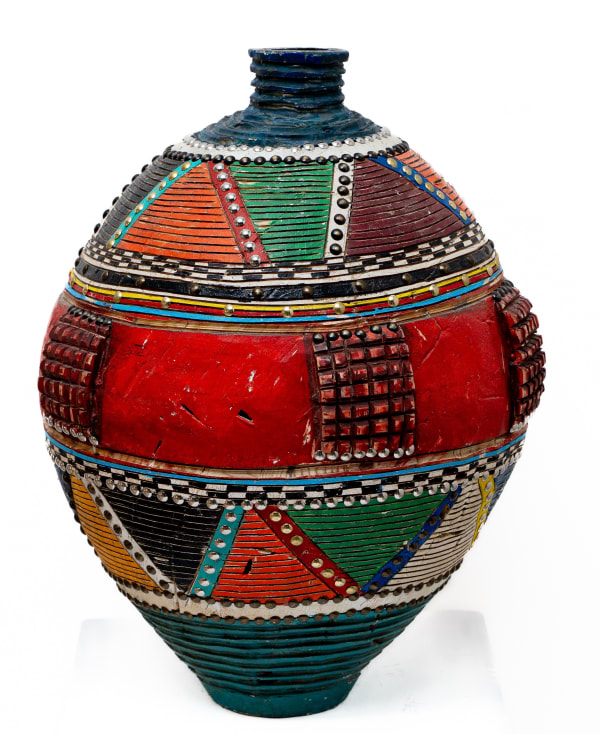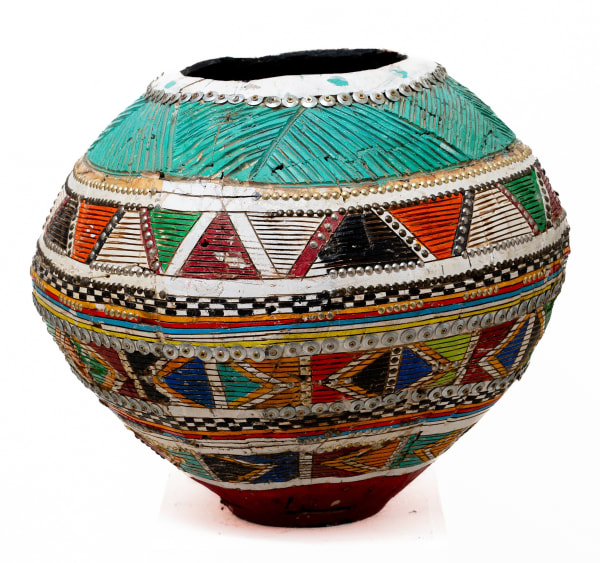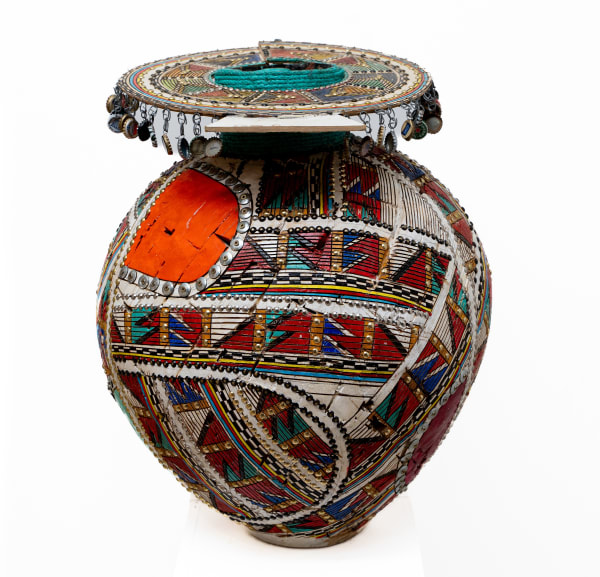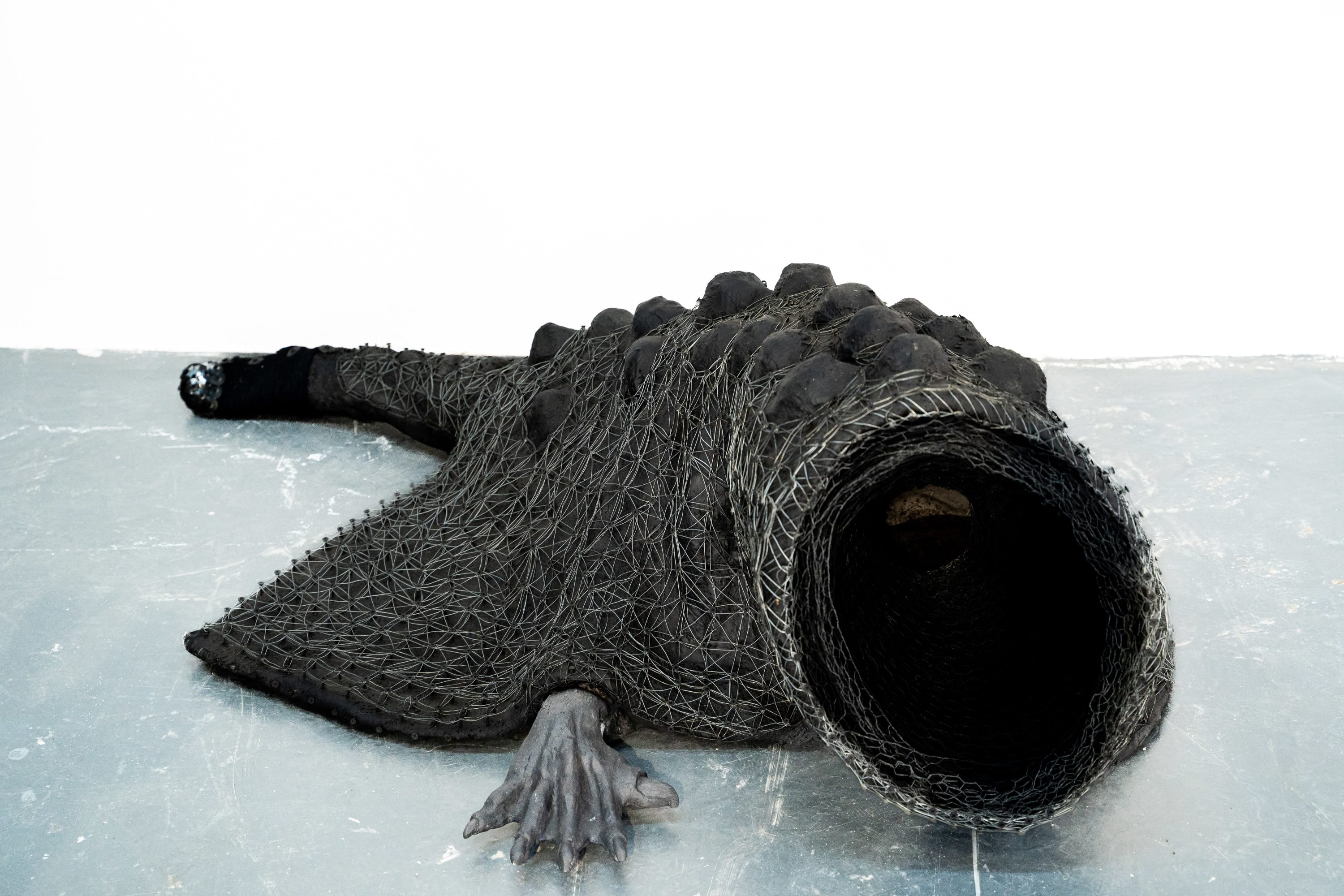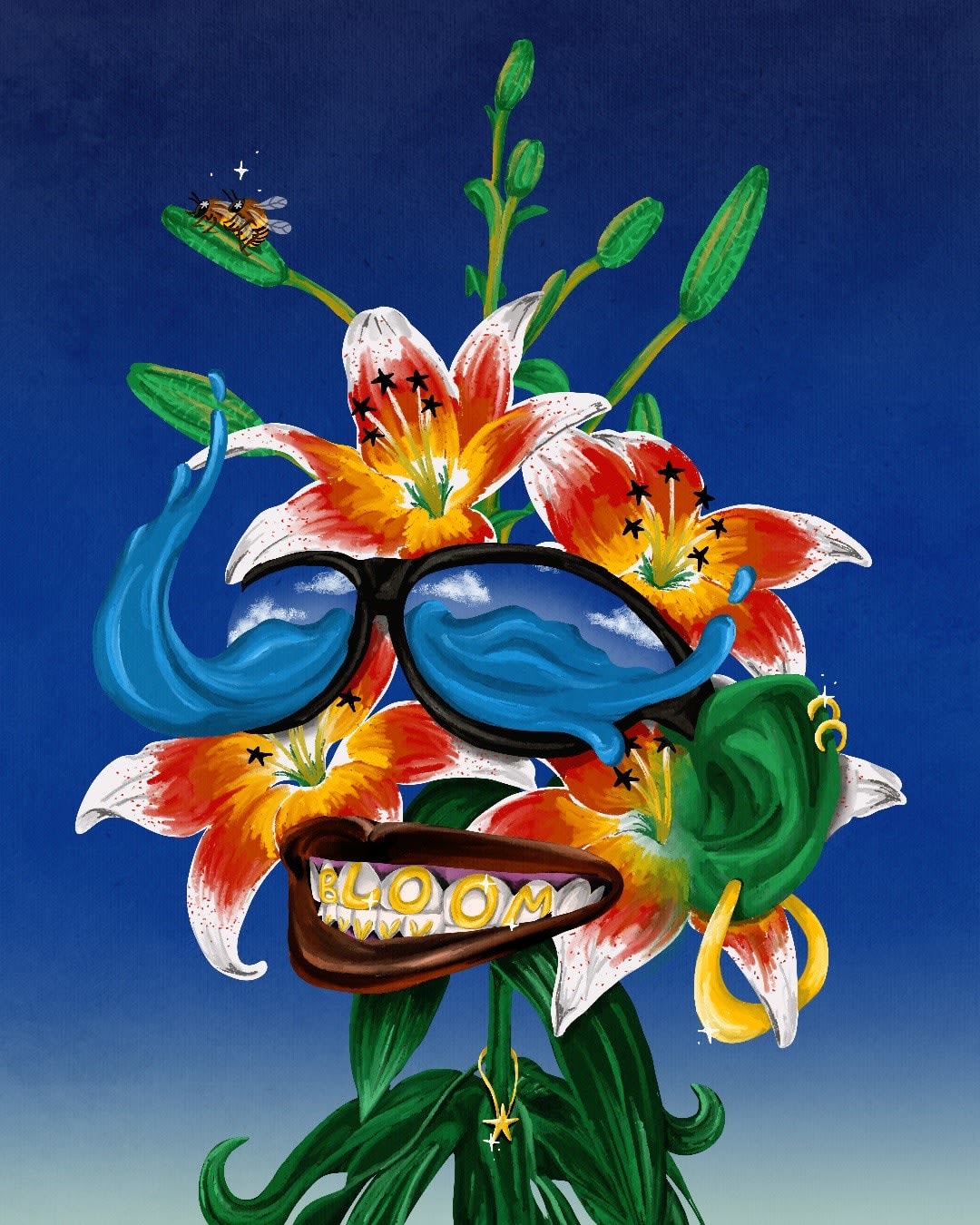-
The Agitation to Regain... To Regain, The Regeneration of Africa
Participating Artists-

Adele van Heerden
Adele van Heerden (b. 1989) is a Cape Town-based artist whose work in painting and photography explores the phenomenon of the ‘waterbody’ and moments in-between. She holds diplomas from Ruth Prowse School of Art and the University of South Africa. Her solo exhibitions include Mirror (2024) and Oceanic (2023).
-

Arlene Amaler-Raviv
Arlene Amaler-Raviv is an experienced painter from South Africa whose works have been exhibited both locally and internationally. Moving several times across many cities and countries, her work is influenced by themes of displacement, transition, and relocation. Amaler-Raviv paints the human condition through her blend of figuration and abstraction, producing emotionally charged paintings that represent larger political themes.
-

Ayanda Mabulu
Ayanda Mabulu is a self-taught artist whose work focuses on social upheavals and matters affecting the politics of the black body. He currently lives and works in Jo- hannesburg. Mabulu is best known for using hyper-realistic imagery in his paintings and sculptures to depict and juxtapose powerful leaders, masters, and mistresses with common African traditional people. Tackling the issues of inequality through his experiences in South African society, especially those that set the black body as an area where violence occurs, Mabulu is an internationally recognized South African artist. The discourse of power, culture, and identity arranged in narrative sequences that fur- ther exaggerate the already grotesque history of exploitation and its inheritance in postcolonial African states. Mabulu’s narrative is exhibited daily in the minds of his people and dances on their tongues during conversations that seek to rebuild the global African community
-

Bongani Mabulu
Bongani Mabulu, a self-taught visual artist, was born on October 28, 1988, and raised in a township in the Eastern Cape, specifically King Williams Town. Having pursued his school studies in Cape Town from 2007 onward, he completed high school at “Nompendulo High” in 2008 and decided to embark on an art career. Under the mentorship of his brother, Ayanda Mabulu, also a visual artist, Bongani’s artistic journey began to unfold. His initial studio experience commenced at the renowned Greatmore Studios in Cape Town in 2013. In 2016, he relocated to Johannesburg, establishing his workspace at Victoria Yards. The turning point in his exhibition career came in 2017 when he participated in a group show at Maboneng with Meagan, selling most of his artworks directly from the studio through client visits.
-

Chantal Coetzee
Chantal Coetzee is anartist,feminist historian, speakerand radio presenter, based inCape Town.She obtained her degree in Fine Art fromthe University of the Witwatersrand, Johannesburg, in 1987.Since graduating,shehas explored the realm of installation art in Amsterdam, street art in London, runningvarious galleries in Cape Town, andparticipated in numerous exhibitions both locally and abroad. Workingcollaboratively withfellow artistand curator, Sharon Peers,she co-founded The SeeffTrust ArtGalleryandlater3RDiGALLERY,both in Cape Town
-

Clint Strydom
Clint Strydom is a talented South African photographer, lens-based artist and photo essayist with a profound gift for capturing humanity. His lens-based artistry unravels the hidden perspectives of the overlooked or forgotten in society, resulting in work that is timeless, measured and still.
-

Fathema Bemath
Fathema Bemath, born in 1971, spent the early years of her childhood around Diagonal Street, Johannesburg. The cosmopolitan landscape of Johannesburg town in the early 1970s piqued the curiosity of individuals with a deep appreciation for art. Fathema and her family relocated to Lenasia, a more insular society that considered art to be an indulgence, potentially subversive and anti-religious.
-

Frans Moshimanyana Thoka
Born in Polokwane, Limpopo in 1997, Frans Moshimanyana Thoka is an emerging contemporary artist. He attended and obtained his BA in Visual Art from the University of Johannesburg; however, he regards himself as a self-thought artist. Thoka’s work revolves around the concept of being humane, or rather, common humanity in a shared universe, and reinforces the need for dignity and kindness. Thoka’s artistic approach is personal, reflecting the trials and tribulations of his upbringing. He uses references to prison and Basotho blankets as his medium, which emphasizes the bare necessities available and reminds the onlooker of the reality of the marginalized.
-

Gaelen Pinnock
I am an architect and artist based in Cape Town, South Africa. I use various techniques to explore and document expressions of power in the urban landscape. My work scrutinizes the legacies of failed utopian visions and the shadows cast by laws, societal structures and urban development. I am preoccupied with the patterns that underlie our cities, obscured by the myopia of day-to-day existence: masked by the glitz of developments and the creep of securitised precincts; ignored by the clustering of suburbs and the ebb and flow of traffic; pushed aside by our own fears and prejudices.
-

Hussein Salim
As a result of the socio-political unrest caused by the First and Second Sudanese Civil Wars, Hussein Salim, along with million others, was forced to flee his native Sudan and spend a number of years as a refugee in countries like the UK, Germany, Egypt and South Africa. His work, characterised by its use of vibrant colours, the layering of intricate patterns and the impasto painting technique, describes his journey of displacement while celebrating his homeland’s diversity and multicultural communal root.
-

Karla Nixon
Karla Nixon, born in 1990, spent her early childhood on a sugarcane estate in Swaziland before relocating to Durban, South Africa. She is a Durban based artist who predominantly works with paper. She hand-cuts, tears and sculpts intricate images and objects, drawn from her surrounding environments. She has used this medium to explore a multitude of themes each with underlying notions of Space and Place. Although paper is central to her practice she works across disciplines with painting, sculpture, mixed media, collage, video, and installation.
-

Mondli Augusine Mbhele
I have been working for six years with a collective of young Durban-based artists that promotes hard work and solidarity amongst fellow artists- the Amasosha Art Movement. During Covid19, I built my studio at home in Cato Manor. I have been working in my studio, creating a body of work because, as a full-time practising artist, it is a must for me to create.
-

Ndikhumbule Ngqinambi
Cape Town-based Ndikhumbule Ngqinambi is a painter and multimedia artist. He has won numerous international awards and artist’s residencies at Djerassi in California, Thami Mnyele in Amsterdam, Sacater in Brazil, Akademie Schloss Solitude in Germany, and IESPIS in Malmo, Sweden. He has collaborated with dancers, performing artists and musicians, exploring the genesis of his paintings through movement and sound. He is represented by Barnard Gallery in Newlands, Cape Town.
-

Ndabuko Ntuli
Ndabuko Ntuli (b.1975) in KwaZulu Natal, South Africa. Ntuli is a Multidisciplinary artist,producer, sangoma, musician and spiritualist. Being born and raised in the Zulu heartland of Kwa-Zulu Natal and moving to Johannesburg at a young age, Ntuli has already enjoyed a storied and diverse career. His proud Zulu heritage informs his art, each piece never quite being the same as the last whether it is painted, sculpted, made from discarded materials or drawn.
-

Oscar Korbla Mawuli Awuku
My body of art is called Anansinisim. it was inspired by the Ghanaian mythical character kweku Anansi. Anansi is an Akan name given to the spider. I carefully fuse visual networking designs of the spider with historical Ghanaian Adinkra symbology to creat personal transitional designs on the body that re-eco knowledge and wisdom of our ancestors that are gradually loosing their sustainable values and norms to contemporary audiences. I represent them with tales of great women here in Ghana and deities alike.
-

Paballo Majela
Paballo Majela is a young emerging South African artist based in Pretoria. Majela was born in the Free State, QwaQwa 1990. He is currently completing his Btech in Fine Art at Tshwane University of Technology. During 2016 he was part of the TUT/NHP-NPC National Heritage Mentorship Programme. Majela’s maquette was one of three works modelled to life size; which is now part of the National Heritage Monument. The mentorship programme also included the transfer of advanced flexible mould making skills, which facilitated Majela moulding the life size figure he produced. In 2017 he worked along with 2 artist by the name of Kgaogelo Mashilo and Zelda stroud in making of the OR Tambo the sculpture that was installed at the OR Tambo international airport. His specialties are Drawing and Sculpture and currently a student assistant at tut.
-

Pitika Ntuli
Pitika Ntuli was born in 1940 in Springs and grew up in Witbank in Mpumalanga. While a teacher, artist and critical thinker living under the threat of apartheid in the sixties and seventies, Ntuli was forced into exile in Swaziland and arrested and made a political prisoner until 1978, when international pressure forced his release to the UK. Having already completed an MFA at Pratt Institute in New York in 1977, he finished an MA at Brunel University in London, in 1985 after which he lectured art at various international and South African universities including; Central St. Martin’s College of Art and Wits University. He was an artist in residence in the 1980s and ‘90s at schools and colleges in London
-

Raja Oshi
Raja Oshi is a Sudanese artist now living in South Africa. Graduated from the College of Fine and Applied Art at the Sudanese University of Science and Technology in Khartoum in 1994, her journey of diaspora, and that of her family, has taken her through Norway, Wales, France and Egypt. From 2004 to present, she has settled in Pietermaritzburg where she completed a postgraduate diploma in Fine Art from the Centre for Visual Arts at the University of KwaZulu-Natal in 2006, raised a family and has continued to paint.Raja’s work is inspired by her life context and what is happening in the world. Living in Sudan, her early work depicts the situation of Sudanese women and things going on in their lives. Being part of this moved her and this came out in her paintings. Her work from that period carries the pain and the desire to change things. Her recent, depicts a new moment.
-

Sinalo Ngcaba
Sinalo Ngcaba, a dynamic self taught artist working in the realms of digital and oil pastel, illuminates the art world with their distinctive voice. Hailing from East London but based in Cape Town and LA, Ngcaba draws inspiration from the vibrant tapestry of Afro surrealism, infusing each creation with a burst of colours. Ngcaba's artistic journey is a fusion of traditional and contemporary mediums, with a mastery of digital techniques and the tactile allure of oil pastels. Born with a passion for storytelling through art, Ngcaba's portfolio is a testament to the celebration of black experiences. She has worked with Nike, Spotify, Black Market Flea (LA), NATIVE, Mr Eazi, Noname and LA Galaxy just to name a few.Each of her creations is an invitation to embrace the beauty and resilience inherent in the diverse narratives of black life. -

Willie Bester
Willie Bester is cited globally as one of South Africa's most important resistance artists. He incorporates recycled material into his paintings, assemblages and sculpture, creating powerful artworks that speak against political, social and economic injustice. For Willie, the personal is political, and being apolitical in South Africa is “a dangerous luxury that we cannot afford”.
-
-
The Agitation to Regain... To Regain, The Regeneration of Africa
Curatorial Statment by Ruzy RusikeThis reflection prompts an exploration of identity and agency within systems and relationships, emphasising the dynamic nature of existence and the imperative to engage in continual regeneration. The Agitation to Regain... To Regain, The Regeneration of Africa advocates for a collective awakening and active participation in reshaping the narrative of Africa, rooted in a deep understanding of history, identity, and the transformative power of agency.
A wise individual once observed that one of the most perilous situations is that of a contented slave, a notion vividly illustrated by Malcolm X through his analogy of the 'house negro' and the 'field negro.' The house negro, residing within the master's home, internalizes the oppressor's perspective to the extent that when the house is on fire, he says, "Our house is burning," whereas the field negro, subjected to harsher conditions, responds, "Let it burn down." This dichotomy underscores the critical role of perception in one's circumstances, highlighting how internalised oppression influences responses to adversity. Steve Biko encapsulated this idea, asserting, "The most potent weapon in the hands of the oppressor is the mind of the oppressed." The identification processes of both the house negro and the field negro reveal a shared origin yet fundamentally divergent articulations of their realities. The house negro's alignment with the oppressor and the field negro's resistance exemplify the reproduction of authoritarianism and injustice, illustrating how fear and subjugation are internalized and manifested. Thus, the internal psychological state of the oppressed emerges as a crucial battlefield against injustice, reflecting the broader dynamics of power and control within oppressive systems.The Agitation to Regain... To Regain, The Regeneration of Africa delves into the theme of reclaiming agency and revitalising the African continent. It addresses both external and internal forms of oppression, emphasising the critical examination of societal structures and the need for a collective awakening. This exhibition begins by highlighting the peril of contentment in oppression, as illustrated by Malcolm X's analogy of the "house negro" and the "field negro." This analogy underscores the divergence in responses to injustice within the educated class, emphasising the need for critical examination of societal structures.But also exists in conversation with 30 Years of Wishful thinking to showcase the life cycle of our democracy and what it means today in conversation with our tomorrow or simply today. Today being the conversation around power, sexuality, censorship, freedom, technology, spirituality, time, space, access and more. The conversation is constantly changing but there remains an urgency of the present moment, acknowledging the culmination of a historical cycle marked by decolonization movements and socio-political shifts that still evoke the past.This reflection prompts an exploration of identity and agency within systems and relationships, emphasising the dynamic nature of existence and the imperative to engage in continual regeneration. The Agitation to Regain... To Regain, The Regeneration of Africa advocates for a collective awakening and active participation in reshaping the narrative of Africa, rooted in a deep understanding of history, identity, and the transformative power of agency."To regain" embodies the idea of reclaiming agency and revitalising African narratives, especially those rooted in cultural heritage and deep-rooted myths. By acknowledging and celebrating these narratives, the exhibition seeks to reclaim lost aspects of identity and empower communities to reconnect with their roots. Simultaneously, "The regeneration" speaks to the process of renewal and growth, emphasising the importance of integrating art into our collective consciousness that showcase the ways in which the past continues to exists without real and action based interventions.Through the diverse artworks showcased, the exhibition celebrates the diversity, spirit, and economic aspects of African stories, while also highlighting the transformative potential of artistic expression in fostering societal regeneration.In alignment with these themes, the concept of "going to the grassroots" represents tracing our origins and mobilising communities politically and spiritually. It emphasises the significance of bottom-up participation and advocacy, as well as personal connection and intuitive comprehension of spiritual principles. This approach resonates strongly in the current political context of South Africa, where issues such as land reform, economic inequality, and the ongoing fight against corruption necessitate grassroots mobilisation and empowerment.Through intentional gaps and aesthetic density, the exhibition prompts reflection and contemplation, bridging the gap between past and present while carrying forth the significance of our cultural heritage. As we commemorate 30 years of Democracy, this exhibition serves as a poignant reminder of the progress made and the challenges still faced in our journey towards societal renewal. It underscores the interconnectedness of democracy, cultural identity, and creative expression, encouraging viewers to actively engage in reclaiming and revitalising their narratives within the context of a democratic Africa. Ultimately, it fosters a slow yet urgent conversation about the regeneration of Africa within the creative realm, inviting viewers to contribute to the ongoing narrative of empowerment and transformation. -
Featured Artworks
-
 Adele van HeerdenLong Street Baths Deep End, 2023Pastel & Gouache on Film90 x 68 cm
Adele van HeerdenLong Street Baths Deep End, 2023Pastel & Gouache on Film90 x 68 cm -
 Adele van HeerdenConvolution, 2024Pastel & Gouache on Film180 x 126 cm
Adele van HeerdenConvolution, 2024Pastel & Gouache on Film180 x 126 cmAs a swimmer, I am drawn to municipal pools and coastal shorelines. Using my body, sketchbook and camera, I observe and engage. There is an autobiographical component to my practice because of this, a sort of alternative approach to narration that I’m exploring through translating these experiences. Painting water began when I was diagnosed with a hip condition that demanded surgery and a lot of rehabilitation. Swimming is an embodied experience for me now, where the body serves as a sensory apparatus through which revelations are made in spaces/places that have the capacity to hold such shifting.
The interplay between water and light —where water is a substance that affects: refracting and reflecting light— is something that interests me, as well. The role of this dynamic in my compositions is considered when I capture an instant on camera. Then, to re-scribe the sentiment which initially caught my eye, I transfer the memory using pencil and gouache onto drafting film. Using translucent architectural film, I mull over the differences between domesticated and wild water, of fluidity and liminality. My intention is to distil these images down into their finest strands of energy, colour and light. Then, as I deepen the image, turning the paper and painting on either side of the substrate, I’m seeking to add dimension and colour as this mirroring method actualises the memory anew. I allow myself to be guided by both these natural elements and my subverted perspectives: from inside the water; below the water’s surface, from the shore, or the steps of the indoor pool.
-
 Arlene Amaler-RavivI AM A WOMANOil on canvas70 x 70 cmSold
Arlene Amaler-RavivI AM A WOMANOil on canvas70 x 70 cmSold -
 Arlene Amaler-RavivSocial distancingOil on canvas110 x 173 cmSold
Arlene Amaler-RavivSocial distancingOil on canvas110 x 173 cmSold -
Ayanda Mabulu
-
 Ayanda MabuluNOMZAMO NOMZAMO IS WINNIE'S NAME BEEDIDE "WINNIE" HER NAAME IS NOMZAMOMixed MediaPiece 1: 152 x 14 x 272 cm
Ayanda MabuluNOMZAMO NOMZAMO IS WINNIE'S NAME BEEDIDE "WINNIE" HER NAAME IS NOMZAMOMixed MediaPiece 1: 152 x 14 x 272 cm
Piece 2: 185 x 14 x 272 cmR 1,315,000.00 -
 Bongani MabuluBlack Jesus'mixed media55 x 110 cm
Bongani MabuluBlack Jesus'mixed media55 x 110 cm -
- We are people of the Soil as Africans and we had and still have our way of doing things that heals us, builds us, molds us, that connect us to our DNA/ the true essence of who we are, where we come from and where we are going.
- For I felt it being my responsibility to retell the narrative behind and about African Spirituality and the Power that it carries. What it means to its people to be connected, to the Soil, the Forrest, the importance, and significance of every living being in the forest as some of them are Ancestral Animal Guides to our Clans.
- For I felt it being my Ancestors quest for me to tell what it is to be An African Black Spiritual, through my Artistic Creations, with the hope that when people leave this night will be fully equipped as to the power that comes with being connected and knowing your roots, knowing where the umbilical cord of your people was buried.
- The importance of knowing the songs that they sang, praises they sang when there was no rain, or they were hit by drought or they needed to sing when summoning their ancestral powers for protection of their wealth, the guidance of the family structure, nature, opening of third eyes to those ones that were gifted to be the Seers, Divines, Healers, messenger.
- Our generation is roaming around the streets thinking it is cool not to follow your spiritual calling, or to address African spiritual issues that they face because it is rejected by society to practice African spirituality or again because you are given labels and not accepted all just because you have a gift of being able to see things differently.
- I want everyone to leave this night knowing that it is a Gift that one is bestowed with from birth to be spirituality enlightened, to be a dream interpreter, to a traditional healer, just like how in the bible there many of them were so that were there?- It is a Gift from Umvelingqangi to be connected, to everything that he has created on this Earth or even beyond, including those that are late, and them not being “Demons/Demonic” rather your Spiritual guides that comes in different ways to reveal them selves or to deliver what is one’s purpose.CONFESSIONS OF “MAD” BALCK AFRICAN SPIRITUALS is a body of incredible messages from above, under and around. We are going to take you through a series of work that will enlighten, awaken, educate, and most of all bring you back home to your ways with a better understanding of what it is to be an African Black Spiritual -
 Chantal CoetzeeQueen Nandi of the Zulu Kingdom, 2022Acrylic & gold leaf on canvas136 cm in diameter
Chantal CoetzeeQueen Nandi of the Zulu Kingdom, 2022Acrylic & gold leaf on canvas136 cm in diameter -
Clint Strydom
-
This photo essay by photographer Clint Strydom explores the haunting spaces of the historic Number Four prison. Using a Hasselblad camera, Strydom creatively narrates the untold stories of the hidden shadows of those who were incarcerated in Number Four. By photographing the uninhabited spaces and empty isolation cells, he captures the soul of the prison through their evocative presence still hovering in the thick, musty air.
-
Fathema Bemath
-
Artist StatementFor five decades, I’ve navigated a path obscured by barriers and hurdles, a journey colored by the intricacies of my identity as a woman of color from a conservative Indian community. Born under the shadow of Apartheid in South Africa, into the embrace of a traditional Muslim family in the 1970s, I found myself grappling with the duality of my existence. As a third-generation South African, my life was deeply entrenched in the patriarchal norms to which my conservative family subscribed. These influences grew more pronounced as I began to forge my own path, discovering myself constrained by sexist expectations that define suitable roles for women in society. The conflict I experienced was not just against external forces but a profound struggle within, a complex dance between my affection for the past and the realization that the roots that sustained me also held me captive. In my studio, I embrace the potential of sculpture to unveil the strength concealed within the female form. My hands transform raw material into manifestations of defiance, casting light on the fierce determination of women who dared to confront their circumstances. Yet beneath the malleable clay lies a deeper, more personal revelation: a reflection of my journey, an introspection of my own narrative. Through the dust and fragments emerged not just the visage of empowered women, but the echoes of my internal struggle. The very foundation I sought to undermine is intertwined into my essence, an enigmatic blend of love and resentment. In my studio's sacred silence, I've embraced a journey of acceptance—a cathartic expedition through stages of acknowledgement and release.
-
Frans Thoka
-

-
-
This body of work reflects on the impact of the Natives LandAct of 1913 ontraditional and cultural practices of black people, the previously and presentlymarginalised. The artworks depict an aerial view of a grave yard.In this body of work, Thoka hints at the bodies (represented by the patches onthe ground within the composition) and the hidden histories in the land, in hisuse of textures, stitched outlines, and shadowy figurations. In so doing heaugments his modus operandi of revealing the trauma beneath the surface; theunmarked, unrecorded, abandoned graves before and during the Natives LandAct/ Apartheid/ Colonialism.Inculturalpractices, graves serve as portals of communication between theliving and Badimo. On the other hand, graves are areas of remembrance, a placewhere one remembers the bodies underneath and also where they come from.The Natives Land Act not only dislocated the black majorityfrom the landbutalsodisconnected them from their cultural heritage.For instance, everydescendant not only inherit genes from their forefathers but alsothe graveswhere the forefathers are buried, because through these graves anunderstanding of one’s presence is found. In the present South Africa,blackdescendantsare denied access tothese gravesthrough seclusionresulting in theloss/limiteduse of the graves in traditional practices.Furthermore , thiscreatesan internal disputeanddistressin blackcommunities /Bantustanswhere thedescendantsareconstantlyagitated and questioningtheir identity,O ya kae o satsebe gore otšwa kae?Thoka’s motif, the prison blanket, represents how unhealed past traumas keeppeople in a ‘refugee’ state. For example, duringcrisis, humanitarianorganisationswill distribute such blankets to refugees. In essence, South Africa is in a state ofinternal dislocation and migration because of its fragmented and Apartheid past.The use of wool as a material in his work also represents the fragility of memory,land, and humanity.
-
-
Hussein Salim
-
 Hussein SalimSomewhere in Africa, 2024Acrylic on canvas180 x 90cm
Hussein SalimSomewhere in Africa, 2024Acrylic on canvas180 x 90cm
18 pieces.As an Artist, expression has come to me as a matter of trying to grow the feeling and capturing the essence of the little things in life (the details) in their presence and their absence. My aim was refreshing the memory of the viewer, about shifting environments and its people. My aim was to draw light to the tiny details that no one pays attention to. It is always a process to fully create the replicas of my view of space, atmosphere and the “ins-and-outs” of these microcosms. It is so laborious for people to appreciate the small things in life until they realize that time is running out and attempt to absorb the world all at once. I interpret this as an echo of educating the viewer. Showing the viewer how to listen carefully, and see the “seams” of the great painting that is life. In these artworks, I discovered that my purpose and my aim were the same. The journey that I took (and I still am on) has shown me what I truly want. More. Not more of life, but more from life. The knowledge of this understanding has changed me, as I wake up everyday, I open my eyes a little more. I try to see a little deeper and understand the inner workings of my surroundings. I do this now with a renewed passion, commitment and sense of wonder at my findings. The growing of my experience has led me to rethink my understanding of the very world I live in. The material used to weave the world around us cannot be truly comprehended by the human mind. For someone living the life of royalty to the poorest of the poor, I truly believe that this way of thinking can make life more dynamic and give it depth. My artwork always needs to convey my passion. What I believe, is that artwork is supposed to reach beyond the boundary of the frame and break the laws of physics, society and the very way our minds work. These paintings are my thoughts married with action. These are when I have “jumped out the frame”. I hope you enjoy them as much as I did creating them
-
 Karla NixonOn Our Way 1, 2024Acrylic paint, paper and glue100 x 152 cmSold
Karla NixonOn Our Way 1, 2024Acrylic paint, paper and glue100 x 152 cmSold -
Mondli Augustine Mbhele
-
 Mondli Augustine MbheleBawelise Mha, 2024Textile collage on canvas190 x 280 cmThis work is inspired by my neighbor’s story, Mrs. Nosibani Makhanya. She works as a student patroller, assisting children to cross the road for more than 15 years. She wakes up every Monday to Friday around 04:30 am and comes back home around 16:00 in the afternoon. She earns a salary of less than R 3000.00 and is the breadwinner for a family of nine. Her three children and husband lost his permanent job during Covid-19. Her elderly parents and three unemployed siblings, all of whom are graduates but can’t find employment, are now addicts. When asked about her dreams when she was young, her response was, “Working with children has always been close to my heart.” She says, “I wanted to be a social worker, but unfortunately, that never came to be. But now I have learned to love what I am doing,” and she mentions she is always happy about the lives of children she saves every day, especially during a time when the country is facing crises of load-shedding. Mbhele collects offcuts of fabric from various fashion artists around Johannesburg for use in his collages. He realized that these offcuts have different qualities and value, but when discarded, they become a metaphor for a state of vulnerability. By collecting these offcuts, he creates a new dialogue between that which is discarded and its worth.
Mondli Augustine MbheleBawelise Mha, 2024Textile collage on canvas190 x 280 cmThis work is inspired by my neighbor’s story, Mrs. Nosibani Makhanya. She works as a student patroller, assisting children to cross the road for more than 15 years. She wakes up every Monday to Friday around 04:30 am and comes back home around 16:00 in the afternoon. She earns a salary of less than R 3000.00 and is the breadwinner for a family of nine. Her three children and husband lost his permanent job during Covid-19. Her elderly parents and three unemployed siblings, all of whom are graduates but can’t find employment, are now addicts. When asked about her dreams when she was young, her response was, “Working with children has always been close to my heart.” She says, “I wanted to be a social worker, but unfortunately, that never came to be. But now I have learned to love what I am doing,” and she mentions she is always happy about the lives of children she saves every day, especially during a time when the country is facing crises of load-shedding. Mbhele collects offcuts of fabric from various fashion artists around Johannesburg for use in his collages. He realized that these offcuts have different qualities and value, but when discarded, they become a metaphor for a state of vulnerability. By collecting these offcuts, he creates a new dialogue between that which is discarded and its worth. -
 Mondli Augustine MbheleIqola emasondo sondo (Train with many wheels), 2024Textile collage on canvas120,2 x 210 cmThis work is inspired by song of Legend musician babu Jabu Khanyile, Mbombelesong that wasreleased in 1987. Lyrics goes as follow when they hear sound of the train, they know that isMbombela, train that take them allover the country and they abounded their life hoods and theyboarding khoshu khushu with high hope heading to cities riches they carry their shield and sticksliving behind lot of promises, and love ones asked them when a coming back.This timeless song still even this day after 37years it was released still comment on issues thatwe faced with in this day age.Mbhele collect offcuts of fabric from various fusion artist around Johannesburg for use in hiscollages. He realized that these offcuts have different qualities and value or worth but whendiscarded they become a metaphor for a state of vulnerablility.by collecting and these offcuts, hecreates a new dialogue between that which is discarded and its worth
Mondli Augustine MbheleIqola emasondo sondo (Train with many wheels), 2024Textile collage on canvas120,2 x 210 cmThis work is inspired by song of Legend musician babu Jabu Khanyile, Mbombelesong that wasreleased in 1987. Lyrics goes as follow when they hear sound of the train, they know that isMbombela, train that take them allover the country and they abounded their life hoods and theyboarding khoshu khushu with high hope heading to cities riches they carry their shield and sticksliving behind lot of promises, and love ones asked them when a coming back.This timeless song still even this day after 37years it was released still comment on issues thatwe faced with in this day age.Mbhele collect offcuts of fabric from various fusion artist around Johannesburg for use in hiscollages. He realized that these offcuts have different qualities and value or worth but whendiscarded they become a metaphor for a state of vulnerablility.by collecting and these offcuts, hecreates a new dialogue between that which is discarded and its worth -
 Ndabuko NtuliINKOMO IYAHLABA, 2024Mixed medium92 x 54 x 64 cmR 172,500.00
Ndabuko NtuliINKOMO IYAHLABA, 2024Mixed medium92 x 54 x 64 cmR 172,500.00 -
 Ndabuko NtuliUmafungase , 2024Mixed medium160 x 120 cmR 172,500.00
Ndabuko NtuliUmafungase , 2024Mixed medium160 x 120 cmR 172,500.00 -
Ndikhumbule Ngqinambi
-
 Ndikhumbule NgqinambiIndlu yokukhanya, 2024Oil on paper44 x 61 cmThis collection of worksconsistsof extracts from 2 seriesof works; 1 from“It’sjust aGame”and 2“The houses”“The House”In 2010, I started exploring circles or circle forms as an idea to create new compositions and meaning about certain traditional gatherings. This idea was inspired by the way people sit in rondavel huts during ceremonial practices in African nations. Later, the idea came that I shouldn’t just present this idea of a house in a structural sense, but to use symbols or metaphors, and that these houses should represent dialogue, thought, and reasoning. Also, these aforementioned elements should cast a light around a certain object. Using people, spaces in between, and a central object sort of illuminated whatever this house sitting was about.
Ndikhumbule NgqinambiIndlu yokukhanya, 2024Oil on paper44 x 61 cmThis collection of worksconsistsof extracts from 2 seriesof works; 1 from“It’sjust aGame”and 2“The houses”“The House”In 2010, I started exploring circles or circle forms as an idea to create new compositions and meaning about certain traditional gatherings. This idea was inspired by the way people sit in rondavel huts during ceremonial practices in African nations. Later, the idea came that I shouldn’t just present this idea of a house in a structural sense, but to use symbols or metaphors, and that these houses should represent dialogue, thought, and reasoning. Also, these aforementioned elements should cast a light around a certain object. Using people, spaces in between, and a central object sort of illuminated whatever this house sitting was about. -
 Ndikhumbule NgqinambiImfazwe yesin, 2024Oil on paper44 x 61 cm
Ndikhumbule NgqinambiImfazwe yesin, 2024Oil on paper44 x 61 cm -
 Oscar Korbla Mawuli AwukuTwo In Paradise, 2023Acrylic on canvas118 x 189 cm$ 6,550.00
Oscar Korbla Mawuli AwukuTwo In Paradise, 2023Acrylic on canvas118 x 189 cm$ 6,550.00 -
Paballo Majela
-
 Paballo MajelaSefata Majoeng, 2024Material, screws and wire130 x 161 x 55 cmMy current body of work is based on my upbringing in mountainous setting of Qwa Qwa, my Sotho heritage, and the folklore that existed in my youth. I create sculptures and paintings reimagining the Sesotho culture into a fantasy that is inspired by tales that were once told. In visually narrating the fictional realm of The Thaba- Bosiu Guardians, I aim to archive the rich folklore history of the Basotho people within my artworks, while interrogating and documenting the utopian existence of Makholokoe as subject.
Paballo MajelaSefata Majoeng, 2024Material, screws and wire130 x 161 x 55 cmMy current body of work is based on my upbringing in mountainous setting of Qwa Qwa, my Sotho heritage, and the folklore that existed in my youth. I create sculptures and paintings reimagining the Sesotho culture into a fantasy that is inspired by tales that were once told. In visually narrating the fictional realm of The Thaba- Bosiu Guardians, I aim to archive the rich folklore history of the Basotho people within my artworks, while interrogating and documenting the utopian existence of Makholokoe as subject. -
Pitika Ntuli
 Pitika NtuliExilic BluesSteatiteR 575,000.00
Pitika NtuliExilic BluesSteatiteR 575,000.00 -
 Raja OshiLemon scent, 2024Acrylic on paper84 x 80 cmSold
Raja OshiLemon scent, 2024Acrylic on paper84 x 80 cmSold -
 Raja OshiAfrican brides , 2024Acrylic on paper150 x 80 cm
Raja OshiAfrican brides , 2024Acrylic on paper150 x 80 cm -
Sinalo Ngcaba
-
 Sinalo NgcabaBloomington, 2024Digital paintingR 53,766.10Each of her creations is an invitation to embrace the beauty and resilience inherent in the diverse narratives of black life.
Sinalo NgcabaBloomington, 2024Digital paintingR 53,766.10Each of her creations is an invitation to embrace the beauty and resilience inherent in the diverse narratives of black life. -

-
Installation Images
-
The Agitation to Regain… To Regain, The Regeneration of Africa: Curated by Ruzy Rusike
Past viewing_room
The Melrose Gallery Announces Two Exciting Exhibitions IN CONVERSATION: "The Agitation to Regain… To Regain, The Regeneration of Africa" and "30 Years of Wishful Thinking”
The Melrose Gallery is pleased to announce the exhibitions, "The Agitation to Regain… To Regain, The Regeneration of Africa" curated by Ruzy Rusike, and "30 Years of Wishful Thinking" curated by Sipho Mdanda. These exhibitions opened on 6 July 2024 and will run until 25 August 2024, offering a profound exploration of democracy, cultural identity, and artistic resilience. The exhibitions although separate will also dialogue with each other through panel discussions, performances. Inspired by a conversation between Achille Mbembe and Bayo Akomolafe, and borrowing from the Igbo people's aesthetic of meeting the other to trace patterns of convergence and divergence, this dialogue between Rusike and Mdanda embodies that spirit.













